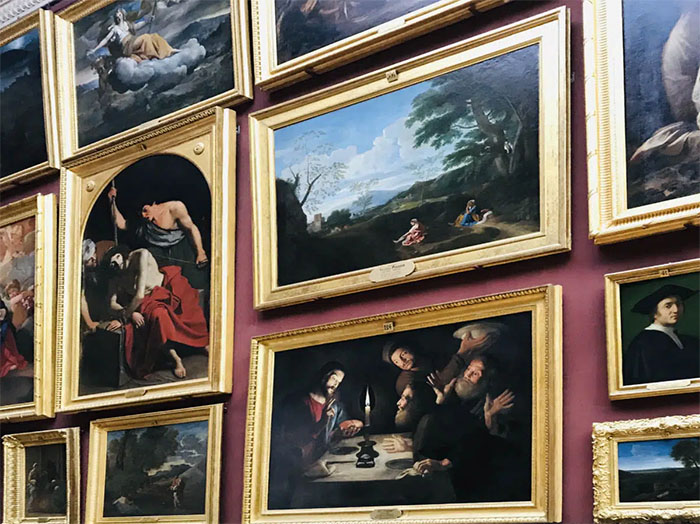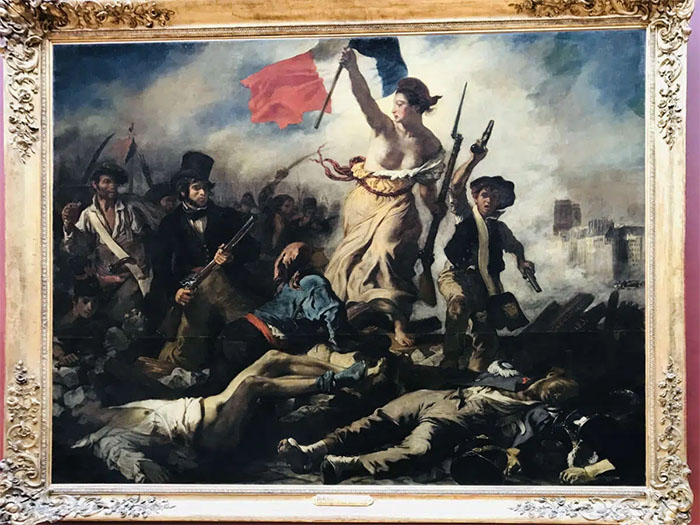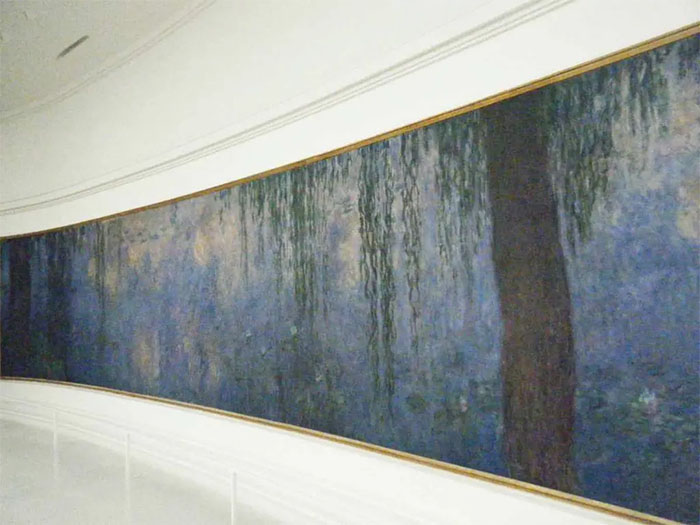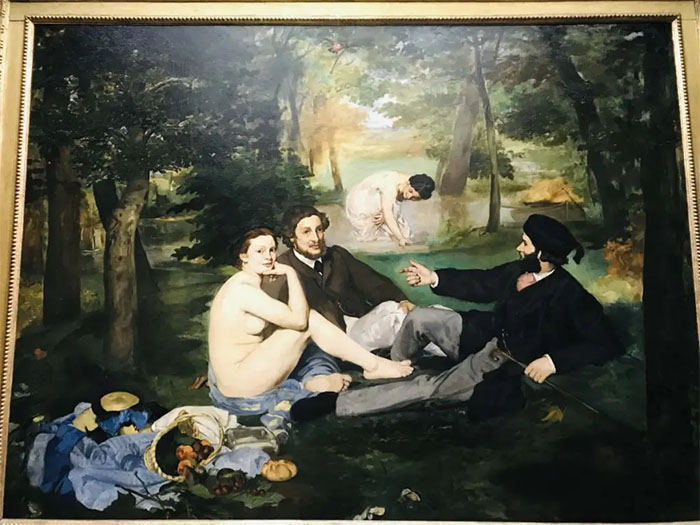A Journey Through French Art: 17 Paintings that Stand the Test of Time
- 1. Liberty Leading the People by Eugene Delacroix (1830).
- 2. Water Lilies by Claude Monet (1915 – 1926)
- 6. Edouard Manet's Le dejeuner sur l'herbe (1893)
- 7. The Absinthe Drinker by Edgar Degas (1876).
- 8. Claude Monet's La rue Montorgueil a Paris (1878)
- 9. Van Gogh's Self-Portrait, 1889
- 10. Gustave Courbet's L'Origine de Monde (1866)
- 11. Marie-Guillemine Benoist’s Portrait of a Black Woman (1801)
- 12. Hyacinthe Rigad's Louis XIV (1701)
- 13. Olympia by Edouard Manet, 1863
- 14. Georges Seurat’s Sunday Afternoon in La Grande-Jatte Island (1884-1886)
- 15. The Raft of the Medusa by Theodore Gericault (1819).
- 16. Vincent Van Gogh’s Bedroom at Arles, 1888
- 17. Paul Cezanne's Card Players (1895)
In this article, you’ll be able to discover the most famous French paintings. These are the French paintings from Cezanne to Delacroix.

France is known for its many famous artists. Many world-known French paintings, from the Middle Ages, Renaissance, and Impressionism to modern post-impressionist art, still inspire a new generation.
French artists are admired all over the world. Their works have been displayed in some of the most prestigious museums in Paris and around the globe, and they have fetched sky-high prices at auction. While the Mona Lisa is Italian, these paintings represent France better than any other and capture the culture of France in a way that no one else can.
Enjoy a journey through art history with some of the most famous French paintings. From Water Lilies by Monet, to Le déjeuner sur l'herbe by Edouard-Manet's!
1. Liberty Leading the People by Eugene Delacroix (1830).
Liberty Leading the People, made by Eugene Delacroix, is one of the most iconic paintings in France. It is displayed at the Louvre and shows Marianne, France's symbol, partially dressed, leading her people to a revolution.

It is the July Revolution (1830) that is in question, not the French Revolution of 1789. Yes, French people protest a great deal.
2. Water Lilies by Claude Monet (1915 – 1926)
Claude Monet, a French impressionist artist at the forefront in the early days of impressionism, is one of the most well-known French artists.

Waterlilies by Claude Monet (Clear Morning with Willows), at the Musee de l'Orangerie.
Monet was born in Paris and began painting landscapes, seascapes, and portraits.
He was famous for his waterlilies, inspired by his gardens at Giverny. He would repeat the same scenes in different lighting conditions and seasons.
You can see some of his works in Paris at the Musee d'Orsay or Musee de l'Orangerie.
3. The Coronation of Napoleon by Jacques-Louis David (1807).
One of the most prominent paintings at the Louvre is the Coronation of Napoleon by Jacques-Louis David.

It depicts Napoleon's coronation at Notre Dame de Paris after he declared himself Emperor.
The Palace of Versailles has a copy by the same painter, with a bit of "creative liberty" to add his mother. She is sitting on a throne at the center.
Napoleon's mother disliked his wife, Josephine, and she refused to come to the event. However, he asked that her portrait be painted anyway.
4. Auguste Renoir's Bal de Moulin de Galette (1876)
Pierre-Auguste Renoir's 1876 painting "Bal dance de Moulin de Galette" is one of his most famous works.
A smaller version of the painting from a private collection in 1990 was sold for $78,000,000. Imagine the price of this large painting on the open markets.

The painting shows a typical Sunday in Paris' Montmartre district at the place of Moulin de la Galette.
Parisians used to dress up and dance with their friends at outdoor parties, drinking until late in the evening. You can still find popular bal dances in Paris, where locals gather to celebrate Bastille Day.
5. Death of Marat by Jacques-Louis David (1793).
Jacques-Louis David was a passionate revolutionary before he became Napoleon's official artist. La Mort de Marat is one of his most iconic paintings, which epitomizes the 1789 French Revolution.
Jean-Paul Marat, a radical journalist and politician during the Revolution, was an ardent defender of sans-culottes. This term refers to those who could not afford silk breeches and were the poorest in society.

He was an icon before he became known for advocating some of the worst atrocities during the Reign of Terror. His skin condition, which required him to spend time in a medicated bath daily, made him ill.
Charlotte Corday, an activist from a revolutionary group opposing the one he was in, would sneak into the bathroom and buy a knife. She stabbed him in the bathroom while he was bathing, making him a martyr for the revolution.
This haunting painting by Jacques-Louis David is currently on display at the Royal Museums of Fine Arts of Belgium.
6. Edouard Manet's Le dejeuner sur l'herbe (1893)
Edouard Manet's "Luncheon on the Grass", painted in 1893, is a large-scale painting measuring 81.9 inches x 104.
The picture shows a naked woman casually sitting at a picnic with various food and two men fully dressed. She looks straight at the viewer while the men appear to be talking and ignoring her.

Edouard was already an established figure in France when the painting was displayed. It received many negative comments when shown first. Even the famous philosopher and writer Emile Zola commented on the woman being painted in a white color while the men were in darker colors.
Many famous artists of Manet's time, such as Paul Cezanne and Claude Monet, along with James Tissot, Paul Gaugin, and Pablo Picasso, were inspired by this painting. They painted picnics in various degrees of nudity.
7. The Absinthe Drinker by Edgar Degas (1876).
Edgar Degas’s painting, sometimes called “In a Cafe”, shows a woman and a man sitting silently side-by-side.

Both look empty and desolate. The woman may be on the verge of tears, and the man is looking elsewhere.
The painting was a reference to absinthe, as it was seen by many as a denial of the dangers associated with this rather harmful liquor that was later banned. The painting is currently on display in the Musee d'Orsay, Paris.
8. Claude Monet's La rue Montorgueil a Paris (1878)
You will fall in love with Rue Montorgueil if you walk around the center of Paris. This lively pedestrianized street is lined with small shops and cafés on both sides.
It is also clear that French artist Claude Monet fell in love with the painting.

Claude Monet's La rue Montorgueil a Paris.
The waving French flags painted in 1878 do not celebrate Bastille Day. It marks the 30th of June 1878 as the day for the "national holiday" of "peace and hard work".
It was a brand new holiday in France at the time. The French republican government promoted it after the humiliation caused by Germany's defeat during the Franco-Prussian War of 1870.
9. Van Gogh's Self-Portrait, 1889
Vincent van Gogh painted his self-portrait in Arles or St. Remy de Provence in 1889, after he had spent a few years in a mental hospital for cutting off his ear.
Vincent van Gogh, a Dutch painter, spent most of his life in France. He lived in Provence and in the area around Paris, where his brother Theo was living with his family.

Even in the self-portrait he took, his face is slightly stressed and anxious.
Van Gogh is known to have enjoyed absinthe. The painting's colors are a mixture of absinth-green and pale turquoise, offset by the beard in a bright orange color.
10. Gustave Courbet's L'Origine de Monde (1866)
The Origin of the World has been controversial since its creation in 1866. It was painted by a French artist named Gustave Courbet and shows a close-up of a woman's nether region, lying naked on a bed, with her legs spread.

The graphic nature of the painting will always provoke a response, unlike other paintings with almost sterile nudity and are hairless. The picture is definitely NC-17-rated, so I did not include a picture of it. However, you can view one here.
11. Marie-Guillemine Benoist’s Portrait of a Black Woman (1801)
Marie-Guillemine Benoist, one of France's most prominent female neoclassical painters and historians, began training with two other renowned French painters: Elisabeth Vigee Le Brun et Jacques-Louis David.

She painted many well-known pieces. One of the most famous was this portrait of an emancipated slave, which she painted six years after slavery was abolished.
The Louvre now displays this work as a symbol of emancipation for women and blacks.
12. Hyacinthe Rigad's Louis XIV (1701)
Hyacinthe Rigaud, a Catalan and French baroque artist born in Perpignan, is best known for his portraits depicting Louis XIV and other members of French nobility.

This painting shows Sun King Louis XIV, who ascended the French throne at age 4. Louis XIV was the one who built the Chateau de Verona.
Sun King Louis XIV ruled over 72 years, the longest reign of any sovereign monarch in European history. Hyacinthe's Rigaud portrait would become one of the most famous French monarchs.
13. Olympia by Edouard Manet, 1863
Edouard manet painted Olympia in 1863. It shows a naked woman lying on a bed with a black servant who is fully dressed.

The nude woman's straightforward stare was enough to shock the viewer when the image was first shown, not because of the contrast between the two figures but rather the direct gaze.
The woman's look was confrontational, assuming she could be a courtesan. Only a lady would accept to be painted in this way. The name "Olympia", associated with escorts during the 1860s, also refers to this period.
Recently, the question about the portrayal of black women has been raised, and why they almost disappear into the background.
For example, "Olympia" was painted 15 years after the end of slavery in France and its empire. However, negative stereotypes continued to persist.
14. Georges Seurat’s Sunday Afternoon in La Grande-Jatte Island (1884-1886)
The French post-Impressionist painter is most famous for using pointillism to create small, uniform dots.

Georges Seurat’s Sunday Afternoon in La Grande-Jatte.
The Art Institute of Chicago displays this large oil painting that measures 81.7 cm x 121.25 cm (207.6cm x 308cm).
The painting depicts a group of aristocrats on Ile de Jatte. This is a large island located in Neuilly sur Seine, a suburb of Paris.
Neuilly-sur-Seine, the richest commune in France, is the home to the French bourgeoisie, as Seurat's picture shows.
15. The Raft of the Medusa by Theodore Gericault (1819).
Theodore Gericault, a French Romantic artist, was only 27 when his masterpiece was finished. It measures 16 ft. 1 in. x 23 ft. 6 in. and depicts an imagined moment of real life as envisioned by the artist.

In 1816, a French naval frigate named Meduse, which was on its way from Senegal to what is now Mauritania's coast, ran aground.
Only 151 of the 400 onboard passengers were resqued on a life raft.
Many drowned or committed suicide after being washed out to sea by the storm. When supplies ran low, survivors began cannibalizing the injured and throwing them into the sea. After 13 days at sea, rescue boats discovered the raft that only had 15 men on it.
France was awash with headlines about the incredible event. Theodore Gericault's painting hangs today in the Louvre.
16. Vincent Van Gogh’s Bedroom at Arles, 1888
Van Gogh painted his bedroom, a small bachelor's room in Arles in Provence.

This painting was created in 1888 and is based on his bedroom at the Yellow House on Place Lamartine at Arles.
Van Gogh painted at least three versions of this picture, one in the Van Gogh Museum of Amsterdam and the other in the Art Institute of Chicago. The third painting is at the Musee d'Orsay.
17. Paul Cezanne's Card Players (1895)
Post-Impressionist French painter known for his repetitive small brushstrokes, built into complex fields. His series of Card Players are one of his most famous paintings.

In 2011, one of the five paintings from the Card Players Series was sold to the Royal Family of Qatar at around $250 million.
Cezanne's Card Players is currently exposed in the Musee d'Orsay. It depicts Provencal farmers smoking pipes and playing cards.
No Comments Yet...